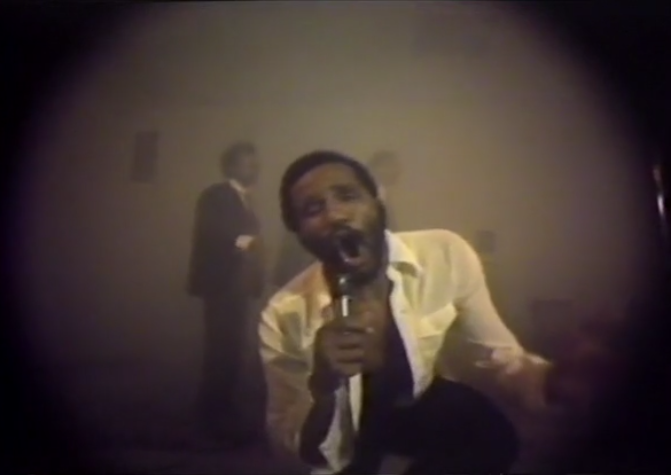Ulysses Jenkins: Artist Talk and Screening
Ulysses Jenkins: Artist Talk and Screening
Electronic Arts Intermix (EAI) is pleased to present an evening with Ulysses Jenkins, organized in conjunction with the exhibition Broadcasting: EAI at ICA. Explicitly deconstructing racial stereotypes in media, Jenkins—whose work is a key feature of the exhibition—explores themes of message transmission, image representation, and broadcasting as a subject and strategy. Works to be screened at EAI include Two-Zone Transfer (1979), Mass of Images (1978), Dream City (1981), and Planet X (2006), and will be followed by an artist talk. This evening is part of a rare East Coast appearance by Los Angeles-based Jenkins, who will also participate in events at ICA and EMPAC.

|
Thursday, March 22nd, 2018 7:00pm Electronic Arts Intermix (EAI) 535 West 22nd Street, 5th Fl. New York, NY 10011 www.eai.org Admission $7, Students $5 Free for EAI Members |
Ulysses Jenkins’s video and media work is remarkable for its fusion of forms to conjure vibrant expressions of how image, sound and cultural iconography inform representation. Beginning as a painter and muralist, Jenkins was introduced to video just as the first consumer cameras were made available to individuals, and he quickly seized upon the television technology as a means to broadcast alternative depictions of African and Native American cultures—his own heritage—citing the catalyst of Melvin Van Peebles’s Sweet Sweetback’s Baadasssss Song (1971) and its call to Black filmmakers to control their subject-hood by controlling the media depicting them.
Adopting the role of a “video griot,” Jenkins draws upon the inspiration of the African oral tradition in videos that are often structured around music and poetic recitation, as well as dynamic performances. The notion of the doggerel is also central for the artist, who communicates complex racial politics in playful or satirical forms, as in Two-Zone Transfer, in which Jenkins and fellow Otis Art Institute students Kerry James Marshall, Ronnie Nichols, and Greg Pitts stage a fever dream of Black identity in America, lent a surreal air by smoke machines and a band of minstrels dressed in Richard Nixon and Gerald Ford face masks. The video concludes with Jenkins’s sensual re-enactment of an ecstatic James Brown performance to a squealing audience.
Technology’s role in building community is a primary concern across Jenkins's works. The artist’s earliest video works were made with the collective Video Venice News, which is most known for its video vérité portrait of the Watts Festival of 1972-73, celebrating Black power and resistance, and community bond. As Jenkins’s solo career progressed, it was guided by his involvement in a California art scene that included his Otis colleagues, the social-realist painter Charles White, Studio Z (along with David Hammons, Senga Nengudi, and Maren Hassinger), Nam June Paik and Laurie Anderson, and Kit Galloway and Sherrie Rabinowitz’s Electronic Café International.
Galloway and Rabinowitz’s ECI projects, which they described as “Aesthetic Research in Telecommunications,” and which were initially sponsored by NASA, the NEA, and the Corporation for Public Broadcasting, inspired Jenkins to fully exploit the communicative and participatory potential of television. In the wake of his experience with ECI’s Hole-In-Space trans-continental video project, Jenkins’s art seems to redress the futility conveyed in his seminal early work, Mass of Images, in which the artist tries but ultimately fails to destroy a stack of TV sets with a sledgehammer. Finding this physical means of destruction blocked, Jenkins pursues alternative methods of breaking down the hegemonic authority of television and White America by creating works that invite starkly new interpretations and involvements, and point to a future informed by an entirely other history.
Following the screening, Jenkins will be in conversation with Rebecca Cleman, Director of Distribution, and co-curator of Broadcasting: EAI at ICA, Dorothy & Stephen R. Weber (CHE’60) Curator Alex Klein.
___________________________________
Ulysses Jenkins was born in 1945, in Los Angeles, California. He studied painting and drawing as an undergraduate at Southern University in Baton Rouge, Louisiana, and later received an MFA in intermedia-video and performance art from Otis Art Institute (now known as Otis College of Art and Design). Prior to enrolling at Otis, from 1970-72 Jenkins worked with the Los Angeles County Probation Department, teaching art to nondelinquent youth, and in 1989, taught video through a gang-intervention program in Oakland. Jenkins is the recipient of numerous awards, including individual artist fellowships from the National Endowment of the Arts, and named first place in experimental video by the Black Filmmakers Hall of Fame in 1990 and 92. His work has been included in major exhibitions, including America is Hard to See (2015), at the Whitney Museum of American Art, Now Dig this!: Art and Black Los Angeles 1960-1980 (2012), at the Hammer Museum, and California Video (2008) at the Getty Center. Jenkins is currently Associate Professor in the Claire Trevor School of the Arts and an affiliate professor in the African American Studies program at the University of California, Irvine.
About EAI
Electronic Arts Intermix (EAI) is a nonprofit arts organization that fosters the creation, exhibition, distribution, and preservation of moving image art. A New York-based international resource for media art and artists, EAI holds a major collection of over 3,500 new and historical media artworks, from groundbreaking early video by pioneering figures of the 1960s to new digital projects by today's emerging artists. EAI works closely with artists, museums, schools and other venues worldwide to preserve and provide access to this significant archive. EAI services also include viewing access, educational initiatives, extensive online resources, technical facilities, and public programs such as artists' talks, screenings, and multi-media performances. EAI's Online Catalogue is a comprehensive resource on the artists and works in the EAI collection, and features expansive materials on media art's histories and current practices:
www.eai.org
___________________________________
Electronic Arts Intermix
535 West 22nd Street, 5th Floor
New York, NY 10011
t (212) 337-0680
f (212) 337-0679
___________________________________